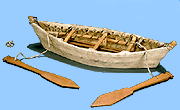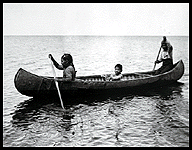 |
The bark canoe, with a strong but light inner framework of wood, combines large carrying capacity with minimum weight. Ideal for travel on the network of lakes and often turbulent rivers that stretch across the northern part of the continent, these portable watercraft were used by First Peoples in all the provinces and territories of Canada.

The traditional bark canoe was lightweight and a 4.2 metre canoe weighing some 22.7 kg could easily be carried over the many portages of central and eastern Canadian forests. The canoes were also quite strong, and although susceptible to damage from rocks, could carry large loads in very shallow water. They were easily manoeuvred by one person with a single-blade paddle and therefore ideal for the fast streams and frequent shoal waters found in the woodland areas. Some, specially built, were sturdy enough for the rough waters of the bays along the Atlantic coast.
Their performance qualities were soon recognized by early European immigrants, who adopted and copied bark canoes for their own purposes, such as exploration and expansion of the fur trade. More recently, traditional bark canoes have served as prototypes for many of the wood and canvas, wood-strip, fibreglass, aluminum and other canoes that have largely replaced them in the modern world.
 |
Bark Canoe Construction |
| kayaks | umiaks | bark canoes | dugout canoes exhibition photos | conservation | bibliography | other WWW resources credits |
 |

